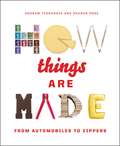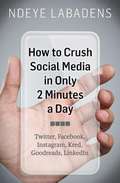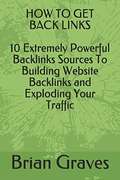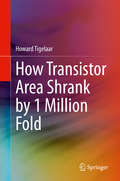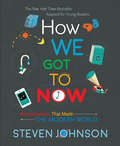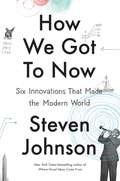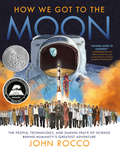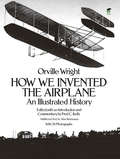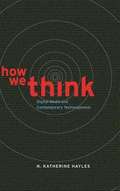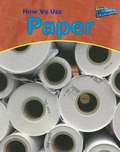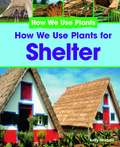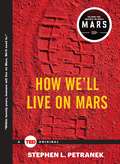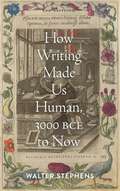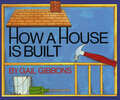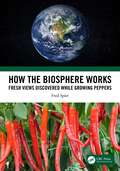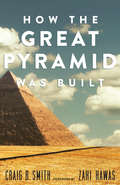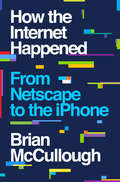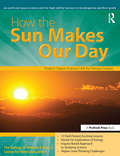- Table View
- List View
How Things Are Made: From Automobiles To Zippers
by Andrew TerranovaFor anyone curious about the nuts and bolts of human ingenuity, How Things Are Made is a fascinating exploration of the process behind the manufacture of everyday items.What are bulletproof vests made of? How do manufacturers get lipstick into the tube? How many layers are there in an iPhone screen? The answers to these questions and so much more fascinating information can be found in How Things Are Made, a behind-the-scenes look at the production everyday objects of all kinds, from guitars, sunscreen, and seismographs to running shoes, jet engines, and chocolate.Thoroughly revised and redesigned from the best-selling 1995 edition, How Things Are Made also contains three new entries by author Andrew Terranova. However, each page still contains informative step-by-step text along with detailed but easy-to-follow illustrations, diagrams, and sidebars to tell the stories behind the things we sometimes take for granted. For example, did you know that Edison didn't really invent the light bulb? Or that the first bar code was on a pack of Wrigley's Spearmint gum? Or that a maple seed inspired the design for the helicopter? Discover these fascinating anecdotes and much more in How Things Are Made.
How Things Work: A Child's First Library of Learning
by The Editors at the Time-Life BooksQuestions and answers provide information about how cameras, elevators, car engines, tops, yo-yos, and other devices work. Includes charts, diagrams, and an activities section.
How To Crush Social Media In Only 2 Minutes A Day: Twitter, Facebook, Instagram, Kred, Goodreads, Linkedin
by Ndeye Labadens James Goonwrite. ComPrepare to Crush the Game of Social Media! This is a fun and powerful method to promote your business, book, or item. Why Do You Need to Crush Social Network? This book offers step- by- step instructions to build your social media presence with your platforms and /or blog. You'll have access to multiple resources to help increase your sales and your online presence. For example, do you know the best keywords to use? When is the most beneficial time to use Twitter? How do you change listings on Goodreads? You'll find answers to these questions and many more. Prepare to Crush the Social Media in Only 2 Minutes a Day is a must-have!
How To Get Back Links: 10 Extremely Powerful Backlinks Sources To Building Website Backlinks And Exploding Your Traffic
by Brian GravesOver 60 website examples where you can find these 10 different back linking types, ranging from PR4-PR9.You also get strategies for each link type that you can use to increase website traffic.
How To Publish An Ebook Without Going Nuts... And So Somebody Reads It
by Alejandro Aguayo Charlotte CoombeSecond expanded edition of this simple step-by-step guide to publishing an eBook without dying in the attempt and how to avoid the typical beginner's mistakes. Full of tips, resources, software recommendations and above all the experience and advice of many "indie" authors currently enjoying eBook success, such as Blanca Miosi, Bruno Nievas, Enrique Laso, Gabri Ródenas, Lidia Herbada, Blas Ruiz Grau, Roberto Lopez-Herrero, Largo Javariega and others.
How To Swallow A Pig: Step-by-step Advice From The Animal Kingdom
by Steve Jenkins Robin PageIn the latest eye-catching escape into the kingdom of Animalia, Steve Jenkins and Robin Page reveal the skills animals use to survive in the wild in an imaginative and humorous how-to format. With step-by-step instructions, readers learn about specific behaviors; how to catch thousands of fish like a humpback whale or how to sew up a nest like a tailorbird. This fascinating and fun illustrated nonfiction melds science, art, biology, and the environment together in a detailed and well-researched book about animals who live and survive in our world today.
How Transistor Area Shrank by 1 Million Fold
by Howard TigelaarThis book explains in layman’s terms how CMOS transistors work. The author explains step-by-step how CMOS transistors are built, along with an explanation of the purpose of each process step. He describes for readers the key inventions and developments in science and engineering that overcame huge obstacles, enabling engineers to shrink transistor area by over 1 million fold and build billions of transistor switches that switch over a billion times a second, all on a piece of silicon smaller than a thumbnail.
How Uncertainty-Related Ideas Can Provide Theoretical Explanation For Empirical Dependencies (Studies in Systems, Decision and Control #306)
by Vladik Kreinovich Martine CeberioThis book shows how to provide uncertainty-related theoretical justification for empirical dependencies, on the examples from numerous application areas. Such justifications are needed, since without them, practitioners may be reluctant to use these dependencies: purely empirical formulas often turn out to hold only in some cases. Examples of new theoretical explanations range from fundamental physics (quark confinement, galaxy superclusters, etc.) and geophysics (earthquake analysis) to transportation and electrical engineering to computer science (image processing, quantum computing) and pedagogy (equity, effect of repetitions). The book is useful to students and specialists in the corresponding areas. Most of the examples use common general techniques, so the book is also useful to practitioners and researchers in other application areas who look for ways to provide theoretical justifications for their areas’ empirical dependencies.
How We Got to Now: Six Innovations That Made the Modern World
by Steven JohnsonDid you drink a glass of water today? Did you turn on a light? Did you think about how miraculous either one of those things is when you did it? Of course not--but you should, and New York Times bestselling author Steven Johnson has. This adaptation of his adult book and popular PBS series explores the fascinating and interconnected stories of innovations--like clean drinking water and electricity--that changed the way people live.Innovation starts with a problem whose solution sets in motion all kinds of unexpected discoveries. That's why you can draw a line from pendulums to punching the clock at a factory, from ice blocks to summer movie blockbusters, from clean water to computer chips.In the lively storytelling style that has made him a popular, bestselling author, Steven Johnson looks at how accidental genius, brilliant mistakes, and unintended consequences shape the way we live in the modern world. Johnson's "long zoom" approach connects history, geography, politics, and scientific advances with the deep curiousity of inventors or quirky interests of tinkerers to show how innovation truly comes about. His fascinating account is organized into six topics: glass, cold, sound, clean, time, light. Johnson's fresh exploration of these simple, single-syllable word concepts creates an endlessly absorbing story that moves from lightning strikes in the prehistoric desert to the herculean effort to literally raise up the city of Chicago to laser labs straight out of a sci-fi movie. In other words, it's the story of how we got to now!
How We Got to Now: Six Innovations That Made the Modern World
by Steven JohnsonFrom the New York Times-bestselling author of Where Good Ideas Come From and Everything Bad Is Good for You, a new look at the power and legacy of great ideas. In this illustrated volume, Steven Johnson explores the history of innovation over centuries, tracing facets of modern life (refrigeration, clocks, and eyeglass lenses, to name a few) from their creation by hobbyists, amateurs, and entrepreneurs to their unintended historical consequences. Filled with surprising stories of accidental genius and brilliant mistakes--from the French publisher who invented the phonograph before Edison but forgot to include playback, to the Hollywood movie star who helped invent the technology behind Wi-Fi and Bluetooth--How We Got to Now investigates the secret history behind the everyday objects of contemporary life. In his trademark style, Johnson examines unexpected connections between seemingly unrelated fields: how the invention of air-conditioning enabled the largest migration of human beings in the history of the species--to cities such as Dubai or Phoenix, which would otherwise be virtually uninhabitable; how pendulum clocks helped trigger the industrial revolution; and how clean water made it possible to manufacture computer chips. Accompanied by a major six-part television series on PBS, How We Got to Now is the story of collaborative networks building the modern world, written in the provocative, informative, and engaging style that has earned Johnson fans around the globe.
How We Got to the Moon: The People, Technology, and Daring Feats of Science Behind Humanity's Greatest Adventure
by John RoccoLONGLISTED FOR THE NATIONAL BOOK AWARDThis beautifully illustrated, oversized guide to the people and technology of the moon landing by award-winning author/illustrator John Rocco (illustrator of the Percy Jackson series) is a must-have for space fans, classrooms, and tech geeks.Everyone knows of Neil Armstrong's famous first steps on the moon. But what did it really take to get us there? The Moon landing is one of the most ambitious, thrilling, and dangerous ventures in human history. This exquisitely researched and illustrated book tells the stories of the 400,000 unsung heroes--the engineers, mathematicians, seamstresses, welders, and factory workers--and their innovations and life-changing technological leaps forward that allowed NASA to achieve this unparalleled accomplishment.From the shocking launch of the Russian satellite Sputnik to the triumphant splashdown of Apollo 11, Caldecott Honor winner John Rocco answers every possible question about this world-altering mission. Each challenging step in the space race is revealed, examined, and displayed through stunning diagrams, experiments, moments of crisis, and unforgettable human stories.Explorers of all ages will want to pore over every page in this comprehensive chronicle detailing the grandest human adventure of all time!
How We Invented the Airplane: An Illustrated History
by Orville WrightIt was the realization of a dream as old as mankind. On December 17, 1903, two bicycle mechanics from Dayton, Ohio, achieved the first sustained, powered, heavier-than-air flight in a machine of their own design and construction. This book offers a concise and fascinating history of that remarkable accomplishment, much of it in the words of the inventors themselves. The heart of the book is Orville Wright's personal account, written in connection with an obscure lawsuit filed against the U.S. government. Long forgotten until a typewritten copy was discovered among the Wright papers at the Library of Congress, it is the best, most detailed account of how the Wright brothers succeeded in creating the machine that lifted man into the sky on wings.The brothers first became interested in the problem of flight after reading about the glider experiments of Otto Lilienthal, a 19th-century German engineer. Experimenting first with kites and gliders, they developed a revolutionary wing design that helped solve the crucial problem of maintaining lateral equilibrium. Later, they added a movable rudder that eliminated the tendency of the machine to go into a tailspin. In addition to these critical innovations, the two inventors developed new accurate tables of "life" pressures and an original theory of air propellers. Slowly, methodically, with patience, perseverance, ingenuity, and inspired invention, they solved the problems that had defeated so many experimenters before them.Finally, on a gusty winter day in North Carolina, the Wright brothers flew their little motor-driven biplane off the sand at Kitty Hawk (actually Kill Devil Hills) and into the pages of history. Although the first flight lasted only about 12 seconds and covered barely 120 feet, it was the first time a machine carrying a man and driven by a motor had lifted itself from the ground in controlled free flight. A new era had begun and the world would never be the same again.The achievement of the Wright brothers is placed in historical context in the absorbing and informative introduction to this volume, written by Fred C. Kelly, author of two standard works on the Wrights. Mr. Kelly has also written an illuminating commentary, including fascinating anecdotes about the Wrights, their personalities and later aspects of their career. As an extra bonus, a lively popular account of the Wrights' success, written in 1908 by both brothers, has been included in an Appendix. Enhanced by 76 photographs, including many rare views of the Wrights and their flying machines, this book offers a thrilling reading experience for anyone interested in aviation, its pioneers, or the mechanics of flights.
How We Think: Digital Media and Contemporary Technogenesis
by N. Katherine Hayles"How do we think?" N. Katherine Hayles poses this question at the beginning of this bracing exploration of the idea that we think through, with, and alongside media. As the age of print passes and new technologies appear every day, this proposition has become far more complicated, particularly for the traditionally print-based disciplines in the humanities and qualitative social sciences. With a rift growing between digital scholarship and its print-based counterpart, Hayles argues for contemporary technogenesis--the belief that humans and technics are coevolving--and advocates for what she calls comparative media studies, a new approach to locating digital work within print traditions and vice versa. Hayles examines the evolution of the field from the traditional humanities and how the digital humanities are changing academic scholarship, research, teaching, and publication. She goes on to depict the neurological consequences of working in digital media, where skimming and scanning, or "hyper reading," and analysis through machine algorithms are forms of reading as valid as close reading once was. Hayles contends that we must recognize all three types of reading and understand the limitations and possibilities of each. In addition to illustrating what a comparative media perspective entails, Hayles explores the technogenesis spiral in its full complexity. She considers the effects of early databases such as telegraph code books and confronts our changing perceptions of time and space in the digital age, illustrating this through three innovative digital productions--Steve Tomasula's electronic novel, TOC; Steven Hall's The Raw Shark Texts; and Mark Z. Danielewski's Only Revolutions. Deepening our understanding of the extraordinary transformative powers digital technologies have placed in the hands of humanists, How We Think presents a cogent rationale for tackling the challenges facing the humanities today.
How We Think: Digital Media and Contemporary Technogenesis
by N. Katherine Hayles“How do we think?” N. Katherine Hayles poses this question at the beginning of this bracing exploration of the idea that we think through, with, and alongside media. As the age of print passes and new technologies appear every day, this proposition has become far more complicated, particularly for the traditionally print-based disciplines in the humanities and qualitative social sciences. With a rift growing between digital scholarship and its print-based counterpart, Hayles argues for contemporary technogenesis—the belief that humans and technics are coevolving—and advocates for what she calls comparative media studies, a new approach to locating digital work within print traditions and vice versa.Hayles examines the evolution of the field from the traditional humanities and how the digital humanities are changing academic scholarship, research, teaching, and publication. She goes on to depict the neurological consequences of working in digital media, where skimming and scanning, or “hyper reading,” and analysis through machine algorithms are forms of reading as valid as close reading once was. Hayles contends that we must recognize all three types of reading and understand the limitations and possibilities of each. In addition to illustrating what a comparative media perspective entails, Hayles explores the technogenesis spiral in its full complexity. She considers the effects of early databases such as telegraph code books and confronts our changing perceptions of time and space in the digital age, illustrating this through three innovative digital productions—Steve Tomasula’s electronic novel, TOC; Steven Hall’s The Raw Shark Texts; and Mark Z. Danielewski’s Only Revolutions. Deepening our understanding of the extraordinary transformative powers digital technologies have placed in the hands of humanists, How We Think presents a cogent rationale for tackling the challenges facing the humanities today.
How We Use Paper
by Chris OxladeFrom the mundane to the extraordinary, paper is used for many things everyday. This title examines the various applications of paper as a starting point for learning about its various properties.
How We Use Plants for Shelter
by Sally MorganPlants are made into materials used to build both the exterior and interior of different kinds of shelters. Some of these materials are wood, timber, straw, and bamboo; and paint, flooring and walls. Readers also learn how to build a model hut!
How We'll Live on Mars: Follow Your Gut, How We'll Live On Mars, And The Laws Of Medicine (TED Books #3)
by Stephen PetranekAward-winning journalist Stephen Petranek says humans will live on Mars by 2027. Now he makes the case that living on Mars is not just plausible, but inevitable.It sounds like science fiction, but Stephen Petranek considers it fact: Within twenty years, humans will live on Mars. We'll need to. In this sweeping, provocative book that mixes business, science, and human reporting, Petranek makes the case that living on Mars is an essential back-up plan for humanity and explains in fascinating detail just how it will happen. The race is on. Private companies, driven by iconoclastic entrepreneurs, such as Elon Musk, Jeff Bezos, Paul Allen, and Sir Richard Branson; Dutch reality show and space mission Mars One; NASA; and the Chinese government are among the many groups competing to plant the first stake on Mars and open the door for human habitation. Why go to Mars? Life on Mars has potential life-saving possibilities for everyone on earth. Depleting water supplies, overwhelming climate change, and a host of other disasters--from terrorist attacks to meteor strikes--all loom large. We must become a space-faring species to survive. We have the technology not only to get humans to Mars, but to convert Mars into another habitable planet. It will likely take 300 years to "terraform" Mars, as the jargon goes, but we can turn it into a veritable second Garden of Eden. And we can live there, in specially designed habitations, within the next twenty years. In this exciting chronicle, Petranek introduces the circus of lively characters all engaged in a dramatic effort to be the first to settle the Red Planet. How We'll Live on Mars brings firsthand reporting, interviews with key participants, and extensive research to bear on the question of how we can expect to see life on Mars within the next twenty years.
How a City Works (Let's-Read-and-Find-Out Science 2)
by D. J. WardRead and find out about how cities work in this colorfully illustrated nonfiction picture book.Millions of people live in cities around the world, but have you ever wondered how cities work? All those people need clean water to drink, a safe place to live, and a way to get all around the city. How do you take care of all those people’s needs? Read and find out all about the systems a city has to help keep everyone safe, healthy, and happy.This book on city systems will appeal to the young civil engineer. How a City Works is filled with fun, accurate art, and includes tons of information. For example, it answers the question: Where does all the electricity needed to make a city run come from? How a City Works covers water treatment, power, sewage, recycling, and transportation.How a City Works comes packed with visual aids like charts, sidebars, an infographic, and a funny, hands-on activity—how to clean up dirty “sewage” water, using puffed rice cereal, raisins, hot chocolate mix, and coffee filters.This is a clear and appealing science book for early elementary age kids, both at home and in the classroom. It's a Level 2 Let's-Read-and-Find-Out, which means the book explores more challenging concepts for children in the primary grades. The 100+ titles in this leading nonfiction series are:hands-on and visualacclaimed and trustedgreat for classroomsTop 10 reasons to love LRFOs:Entertain and educate at the same timeHave appealing, child-centered topicsDevelopmentally appropriate for emerging readersFocused; answering questions instead of using survey approachEmploy engaging picture book quality illustrationsUse simple charts and graphics to improve visual literacy skillsFeature hands-on activities to engage young scientistsMeet national science education standardsWritten/illustrated by award-winning authors/illustrators & vetted by an expert in the fieldOver 130 titles in print, meeting a wide range of kids' scientific interestsBooks in this series support the Common Core Learning Standards, Next Generation Science Standards, and the Science, Technology, Engineering, and Math (STEM) standards. Let's-Read-and-Find-Out is the winner of the American Association for the Advancement of Science/Subaru Science Books & Films Prize for Outstanding Science Series.
How a House Is Built
by Gail GibbonsHouses are built with many different materials, and in many shapes and sizes. Step by step, this picture book explains how homes are built—from the architect's plans through the arrival of a happy family. The many processes of construction are explained with simple language and bright, clear illustrations, perfect for kids starting to wonder about how the world around them works. Many different careers—including carpenters, plumbers, electricians, and landscapers—are introduced, each doing their part to bring the picture wood-frame house to life. A great read for kids who love construction sites, or who can't get enough of Building a House by Byron Barton. According to The Washington Post, Gail Gibbons "has taught more preschoolers and early readers about the world than any other children's writer-illustrator." Ms. Gibbons is the author of more than 100 books for young readers, including the bestselling titles From Seed to Plant and Monarch Butterfly. Her many honors include the Washington Post/Childrens Book Fuild Nonfiction Award and the NSTA Outstanding Science Trade Book Award.
How the Biosphere Works: Fresh Views Discovered While Growing Peppers
by Fred SpierHow the Biosphere Works: Fresh Views Discovered While Growing Peppers offers a simple and novel theoretical approach to understanding the history of the biosphere, including humanity’s place within it. It also helps to clarify what the possibilities and limitations are for future action. This is a subject of wide interest because today we are facing a great many environmental issues, many of which may appear unconnected. Yet all these issues are part of our biosphere. For making plans for the future and addressing our long-term survival and well-being, an integrated knowledge of our biosphere and its history is therefore indispensable. Key Features Documents what the biosphere is, and what our position as humans within it is today. Describes how the biosphere has become the way it is. Summarizes the novel simple theoretical model proposed in the book, and thus, how the biosphere functions. Predicts what the possibilities and limitations are for future human action Emphasizes how simple but careful observations can lead to far-reaching theoretical implications.
How the Earth Works: 60 Fun Activities for Exploring Volcanoes, Fossils, Earthquakes, and More
by Michelle O'Brien-PalmerEarth science comes alive for children 6 to 9 through 60 engrossing games, activities, and experiments. Kids “core sample” a filled cupcake and discover plate tectonics by floating graham cracker continents on a molten mantle of molasses. They learn how heat changes rocks by seeing how separate ingredients disappear when they bake Rice Krispie Treats. More activities show what causes earthquakes and what kinds of buildings resist their force. Growing sugar and salt crystals, “fossilizing” plastic insects, and modeling a variety of volcanoes add to the learning and the fun. Eight of the activities are tasty as well as informative. Silly songs help children remember new words and concepts, and a resource section gives inexpensive sources for rocks, minerals, and fossils. All the projects have been tested in homes and schools to make sure they are safe, effective, and fun.
How the Great Pyramid Was Built
by Craig B. Smith Zawi Hawass Mark LehnerGoing beyond even the expertise of archaeologists and historians, world-class engineer Craig B. Smith explores the planning and engineering behind the incredible Great Pyramid of Giza. How would the ancient Egyptians have developed their building plans, devised work schedules, managed laborers, solved specific design and engineering problems, or even improvised on the job? The answers are here, along with dazzling, one-of-a-kind color photographs and beautiful hand-drawn illustrations of tools, materials, and building techniques the ancient masters used. In his foreword to the book, Egypt's Undersecretary of State for the Giza Monuments Zahi Hawass explains the importance of understanding the Great Pyramid as a straightforward construction project.
How the Internet Happened: From Netscape To The Iphone
by Brian McCulloughTech-guru Brian McCullough delivers a rollicking history of the internet, why it exploded, and how it changed everything. The internet was never intended for you, opines Brian McCullough in this lively narrative of an era that utterly transformed everything we thought we knew about technology. In How the Internet Happened, he chronicles the whole fascinating story for the first time, beginning in a dusty Illinois basement in 1993, when a group of college kids set off a once-in-an-epoch revolution with what would become the first “dotcom.” Depicting the lives of now-famous innovators like Netscape’s Marc Andreessen and Facebook’s Mark Zuckerberg, McCullough also reveals surprising quirks and unknown tales as he tracks both the technology and the culture around the internet’s rise. Cinematic in detail and unprecedented in scope, the result both enlightens and informs as it draws back the curtain on the new rhythm of disruption and innovation the internet fostered, and helps to redefine an era that changed every part of our lives.
How the Sun Makes Our Day: An Earth and Space Science Unit for High-Ability Learners in Grades K-1
by Clg Of William And Mary/Ctr Gift EdHow the Sun Makes Our Day, an Earth and space science unit for grades K-1, engages students in investigations and observations about the sun as a source of light and energy, the nature of shadows, man-made sources of energy, and the need for humans to conserve natural resources.How the Sun Makes Our Day was developed by the Center for Gifted Education at The College of William and Mary to offer advanced curriculum supported by years of research. The Center's materials have received national recognition from the United States Department of Education and the National Association for Gifted Children, and they are widely used both nationally and internationally.Each of the books in this series offers curriculum that focuses on advanced content and higher level processes. The science units contain simulations of real-world problems, and students experience the work of real science by using data-handling skills, analyzing information, and evaluating results. The mathematics units provide sophisticated ideas and concepts, challenging extensions, higher order thinking skills, and opportunities for student exploration based on interest. These materials are a must for any teacher seeking to challenge and engage learners and increase achievement.Grades K-1
